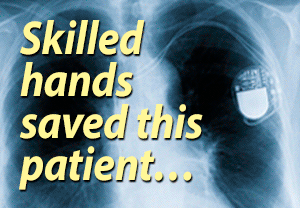 Differences between QRS during procdure vs QRS post=procedure
Differences between QRS during procdure vs QRS post=procedure
- by Andiek11
- 2024-05-05 12:53:39
- General Posting
- 226 views
- 10 comments
Trudging through my operative report from recent pacemaker placement, I see that when the LBB lead was being placed they measured QRS at 125ms at the "sweet spot" where lead was implanted. However, post-procedure ECGs measured the QRS at 152 (down from 164 pre-placement). Can anyone shed some light regarding the differences in QRS measured during the procedure vs the QRS measured after the procedure (like 3 or 4 hours later)? Is something like this common? (I know I need to put this on the list of questions for MD, but I also thought I'd toss it out here based upon the vast knowledge / experience base the site has)
10 Comments
You are still healing
by Gemita - 2024-05-05 17:10:12
I agree with both USMC-Pacer and (DoingMyBest - see your previous post) that QRS duration can be influenced by a number of factors affecting conduction time. QRS duration assessment during pacing of the left bundle branch is complex, particularly if retrograde conduction (backwards conduction through the AV node) is present.
Additionally, remember too your heart was disturbed during the procedure and by the end of the procedure which was lengthy under a general anaesthetic, I would not have been at all surprised to find a heart throwing out many rhythm disturbances as a result of the implant trauma. I wouldn’t read too much into any of this and when things settle and you can safely have adjustments to some of your settings and perhaps get Metoprolol on board to calm any rhythm disturbances like PVCs which can trigger retrograde conduction, your QRS should settle and find its correct level.
My heart took 3 months to heal. I had a terrible time immediately after my implant. I was also kept in hospital overnight and my monitor was bleeping intermittently all night long because of Atrial Flutter and Fibrillation at very high heart rates.
Gemita and USMC-Pacer
by Andiek11 - 2024-05-05 18:18:45
Gotcha. It would be nice if one's care team could provide this simple type of education up front. Hmmm, I guess they figure that all of their patients will magically discover the Pacemaker Club website. ;)
Had to smile about the comment of your monitor beeping all night after your procedure. So did mine - on and off. I just figured since no one was rushing into the room looking in a panic that whatever was going on was nothing major (remarkable what residual drugs in one's system will allow one to accept... *lol*). Okay, I'll try to control my questions and focus on just creating a list for my MD.
Bleepin' monitors
by AgentX86 - 2024-05-05 18:42:45
Last fall, I was hospitalized for a stupid reason, or should I say two stupid reasons.
The first night, alarms went off at 11:00PM, and nurses came running. I was just sitting there , doing baically nothing. They asked if I was alright. "Sure, why wouldn't I be." The alarms were low-HR. Well, at 11:00PM my PM went into sleep mode, down from 80bpm to 50bpm.
QRS During Lead Placement
by DoingMyBest - 2024-05-06 11:30:09
This is my interpretation of what I've read (I'm an engineer, not a doctor - usual disclaimers apply). Hopefully, this is about right and not too distorted. Sorry, I don't have a ready URL to reference at the moment.
My understanding is lead placement is very delicate for achieving left bundle branch (LBB) pacing. One of the ways this fails is puncturing the septum, essentially screwing in too far until the lead pokes through to the left ventricle. If that happens, I believe that spot is spoiled and they have to move and try again elsewhere.
To avoid this problem, they procede slowly and watch the QRS on the live ECG while screwing the lead in. From what I understand, optimal placement occurs when the QRS hits a minimum. (For this example, assume symptoms of LBBB-only and not RBBB, which may change things - I don't know). Anyway, they don't want to risk going too far, and the lead is likely to recoil a bit when rotational pressure is released. So, at some point they say, "good enough," and don't try further to reduce the QRS for fear of going too far.
This is my guess as to why you may see QRS differences in your reports, particularly with regard to the implant procedure.
Love Engineering Minds...
by Andiek11 - 2024-05-06 12:15:07
My first professional career was as an englineer so I love the way your mind works. :) Reading through the surgical report, the slow and steady while taking real-time measurements is what they did. And your logic about the lead possibly backing up a bit from the "sweet spot" once pressure of placement was removed is logical. I'm also now factoring in what Gemita and others have mentioned about my poor heart having been tramatized for all the poking, prodding, and mutliple removal and reinsertion of leads as the procedure changed two thirds of the way through CRT.
I warn all of my providers up front that I am the queen of questions, so they've been forewarned. *eg* I'll add this discussion to my list. I have no goal of back-seat driving, but at the end of the day is still falls on the patient or a close family member, to be keeper of the story as providers don't always remember ever detail and something there are changes in providers.
Many thanks!
You will be well prepared (!)
by Gemita - 2024-05-06 13:26:39
You could perhaps start the dialogue with your doctor by asking him to confirm whether you have Selective or Non Selective Left Bundle Branch pacing? He will be impressed. See the Conduction System Chart link I posted previously. Just to remind us of two pacing positions:
Selective Left Bundle Branch pacing = Capture of the LBB alone, without capture of local myocardium.
Non-Selective Left Bundle Branch pacing = Simultaneous capture of the LBB and local left ventricular septal myocardium.
As you will see from the attached link, a comparison between QRS duration during NS-LBBP and S-LBBP has not been performed, although figures from prior published studies have demonstrated that NS-LBBP yielded narrower QRS duration than S-LBBP. Furthermore, multiple reports show optimized narrowing of wide-paced QRS complexes by programming the AV delay to fuse LBBP with intrinsic RBB activation.
As already mentioned, QRS duration during pacing of the LBB is complex and is influenced by: 1) retrograde conduction from the left bundle to the right bundle branch; 2) integrity of RBB conduction; 3) transseptal activation and nonselective recruitment of the right ventricular septum; and 4) degree of fusion with intrinsic antegrade RBB activation related to the programmed atrioventricular delay. Clear as a bell? Yeah, I know but we have to start to learn this stuff to keep up with our doctors. What a fascinating subject.
Scroll down to Discussion for a summary of findings in Link 1. Link 2 is the Chart on Conduction System pacing:-
https://www.sciencedirect.com/science/article/pii/S2405500X22000329#:~:text=Patients%20with%20retrograde%20left%20bundle,bundle%20branch%20can%20be%20activated.
https://www.radcliffecardiology.com/image-gallery/12837/9611/conduction-system-pacing
Actually scary...in a good way
by Andiek11 - 2024-05-06 14:54:18
Gemita - I think I acutally understood about 90% of what you wrote! 2 weeks ago I could have never said that. *lol* I've been working on my Cardiology and EP qualifitcations from the University of Google over the last 4 days. The links that you and others have shared have all help move my education forwarrd. I was trying to think of a polite way to ask my MD if it was selective or non-selective placement. Direct is usuallly best. I know that I had LLL leads and not SVL leads placed which is good. And the surgical report noted that they had to relocated the LBB lead at least once because the first location yielded no response in metrics. Yep, it is a bit of hunt and peck. I just was so happy with the QRS numbers reported during the placement that then seeing the numbers on the post ECGs made think wonder if perhaps the procedure hadn't worked. However, I now know that it is way to early to even have such thoughts / discussion. I'll return to studing the anatomy and conduction systems of the heart. Oh, and one thing that surprised us all, was the EP discovered I have a redundant, left-sided SCV. Not rare, but unsual. So this tid-bit along with $2 and I can still get a cup of coffed at the local shop. *haha*
I'm about to go silent for a bit beause of a benedryl tab I just took to treat an allergic reation to adhesives from the incision bandages. Small complication but one easily addressed with some short term meds and OTC hydrocortizone cream. (And for any concerned I actually went to my PCP to get a second opinion on the skin rash before I started treating because the wound is still young-ish. NO infection, just an allergic response to the tegaderm they used on the outter bandage). Ciao and thanks (again1)
Only For Those Who Are Really Into It
by DoingMyBest - 2024-05-06 19:53:27
I'm sure we're losing most of the crowd here, but I think it is worthwhile to add a little more to to the thread for future searchers with an interest in LBB/Conduction System Pacing.
The links Gemita provided are very interesting, and as usual, I've learned a lot.
As this topic is complex, with many variables, I now realize it is misleading for us to generalize too much. Some may jump to the wrong conclusions.
The results you get, with respect to QRS duration and resynchronization of the ventricles depend so much on your individual circumstance.
It seems the best outcome is when you have no AV block or RBBB, but only LBBB, in which case fusion, combining LBB pacing with a natural impulse to the RBB, provides the best synchronization and shortest QRS duration.
Where there is AV block or RBBB, it seems that non-selective LBB pacing that includes left-to-right conduction through the myocardium provides a better outcome than selective LBB pacing that relies on retro-grade conduction back through the HIS bundle. [I'm in this category]
Though I haven't seen it spelled out clearly for me, I think there is a strong correlation between minimal QRS duration, ventricular synchrony, and ejection fraction. [Perhaps this is this a "Well, duh..." moment?]
I imagine a Venn Diagram. One circle is left ventricular function, the other circle is right ventricular function. With no overlap, they are disassociated, uncoordinated, and dysfunctional. Fully overlapped, they are 100 percent synchronized, functioning optimally, and the overlap area relates to the ejection fraction (inversely, the minimal QRS duration). A partial overlap would indicate less than perfect synchronization, less ejection fraction, and greater QRS duration. What do you think? Does that diagram work to simplify things?
AndieK, I'm envious of your EP and the detailed procedure report you got after your implant. The report I got from my EP was very terse without any of the fine detail that you received. I found out a bit more upon a followup visit when I quizzed him with a lot of detailed questions (which he couldn't remember given the months that had passed). I wish I could have received what you got.
Doing My Best
by Andiek11 - 2024-05-07 12:06:59
My thinking is aligned with yours. I have seen a couple of papers that say, or seem to say, that a shorted ORS inidcates a more normal rythym without LBBB. This also jives with what a couple of nurses in hopsital told me. I asked if my LBBB was gone and one of the RN's said that looking at the EkG that it appears much more normal with the QRS width only be 2 squares vs more than 2 squares. And 2 squares or less means no LBBB. ( per RN) Again, another MD question. Based upon some papers that Gemita sent, I also want to know if he went with S vs NS placement. I'm sure he made the right choice for me, but my persoal experience with the medical system is that one is a bit silly to be passive wrt major medical concerns and does not "know" what was done and why.
My pacemaker is now a life long, and hopefully life-improving experience, and I want to understand both why things work and why things might not work, and what options lay ahead if needed. Gotta love the engineering brain - either the building stands or the building falls. Best to understand both sides of the equation. :)
Perhaps what a large part of my struggle is that the EP only saw my family briefly after the procedure who were at that time a bit overwhelmed with learning that they went with Plan B to really start to ask questions, etc. Especially my dear hubby; he is NOT a question asker!!! *lol* That job falls squarely in my lap. And my understanding is that at the 2 week check-up at the clinic, I"ll only see NPs / RNs. Love those folks, but I'd prefer my answers come from the head honcho.
Appreciate the dialogue on this topic. AGree that too many others may not find this useful just now, but considering that LBBAP is the future I'm sure the interest in this topic will shift over time. Many thanks!
You know you're wired when...
You can finally prove that you have a heart.
Member Quotes
I'm a runner, mountain climber, kayaker, snow skier, bicycler and scuba diver. The only activity among those that I'm not yet cleared to do is scuba diving, and when I am cleared, I'll be limited to diving to 50 feet.




QRS Duration
by USMC-Pacer - 2024-05-05 15:51:23
I think I wrote this previously to your, or someone elses thread.. Anyway, prior to my box change, my QRSD was 198ms due to PICM. I don't know the procedure QRSD they got, but after the procedure I was at 127ms which slowly over a year has increased to the 150s along with a slight decrease in EF.. I recently inquired as to why that is and their response was that they need to do some tweaks to the AVdelay and VV delay to narrow it down. But I HAD to inquire about this! As I said before, I'm not sure why I need to advocate for this and I think it should be automatic. I have NO symptoms that I am aware of but I hope tweaking will make a difference. Also, a lower QRSD is a good thing as far as improved heart function.